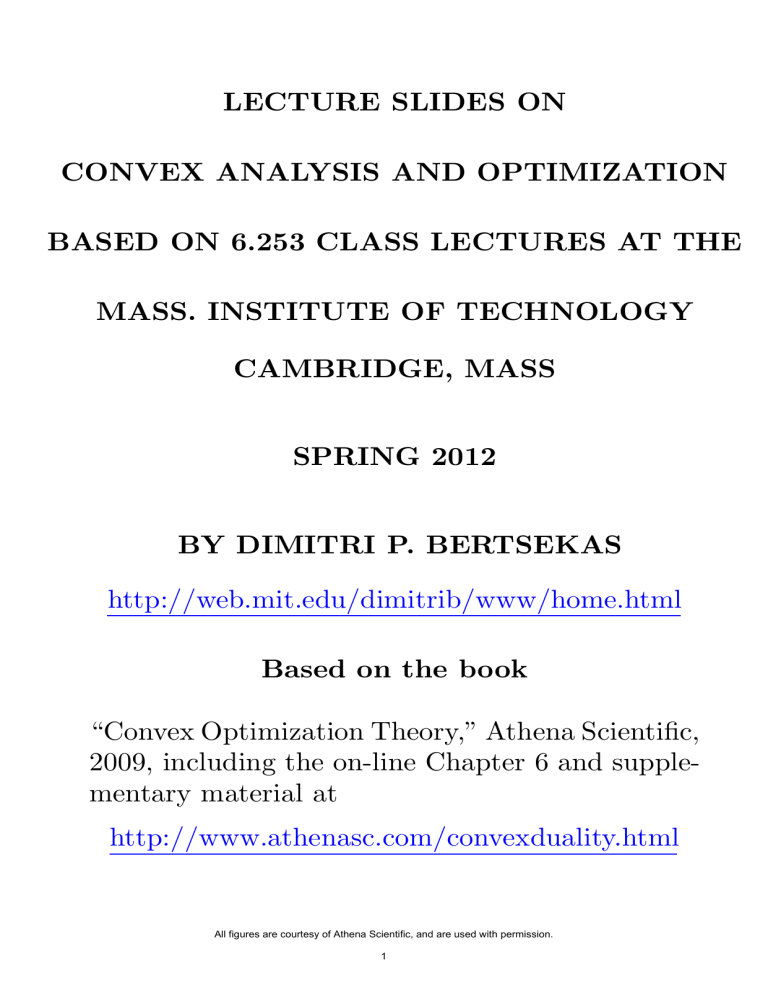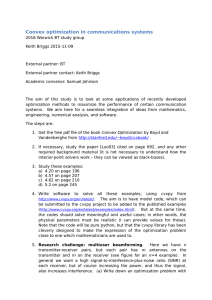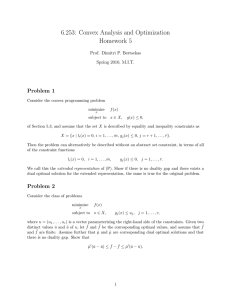LECTURE SLIDES ON CONVEX ANALYSIS AND OPTIMIZATION MASS. INSTITUTE OF TECHNOLOGY

LECTURE SLIDES ON
CONVEX ANALYSIS AND OPTIMIZATION
BASED ON 6.253 CLASS LECTURES AT THE
MASS. INSTITUTE OF TECHNOLOGY
CAMBRIDGE, MASS
SPRING 2012
BY DIMITRI P. BERTSEKAS http://web.mit.edu/dimitrib/www/home.html
Based on the book
“Convex Optimization Theory,” Athena Scientific,
2009, including the on-line Chapter 6 and supplementary material at http://www.athenasc.com/convexduality.html
All figures are courtesy of Athena Scientific, and are used with permission.
1
LECTURE 1
AN INTRODUCTION TO THE COURSE
LECTURE OUTLINE
• The Role of Convexity in Optimization
• Duality Theory
• Algorithms and Duality
• Course Organization
2
HISTORY AND PREHISTORY
• Prehistory: Early 1900s - 1949.
− Caratheodory, Minkowski, Steinitz, Farkas.
− Properties of convex sets and functions.
• Fenchel - Rockafellar era: 1949 - mid 1980s.
− Duality theory.
− Minimax/game theory (von Neumann).
− (Sub)differentiability, optimality conditions, sensitivity.
• Modern era - Paradigm shift: Mid 1980s - present.
− Nonsmooth analysis (a theoretical/esoteric direction).
− Algorithms (a practical/high impact direction).
− A change in the assumptions underlying the field.
3
OPTIMIZATION PROBLEMS
• Generic form: minimize f ( x ) subject to x ⌘ C
Cost function f : � n → � , constraint set C , e.g.,
C = X ⌫
⌫
⇤ x | h
1
( x ) = 0
⇤ x | g
1
( x ) ⌥ 0
, . . . , h m
( x ) = 0
⌅
⌅
, . . . , g r
( x ) ⌥ 0
• Continuous vs discrete problem distinction
• Convex programming problems are those for which f and C are convex
− They are continuous problems
− They are nice, and have beautiful and intuitive structure
• However, convexity permeates all of optimization, including discrete problems
• Principal vehicle for continuous-discrete connection is duality:
− The dual problem of a discrete problem is continuous/convex
− The dual problem provides important information for the solution of the discrete primal
(e.g., lower bounds, etc)
4
WHY IS CONVEXITY SO SPECIAL?
• A convex function has no local minima that are not global
• A nonconvex function can be “convexified” while maintaining the optimality of its global minima
• A convex set has a nonempty relative interior
• A convex set is connected and has feasible directions at any point
• The existence of a global minimum of a convex function over a convex set is conveniently characterized in terms of directions of recession
• A polyhedral convex set is characterized in terms of a finite set of extreme points and extreme directions
• A real-valued convex function is continuous and has nice differentiability properties
• Closed convex cones are self-dual with respect to polarity
• Convex, lower semicontinuous functions are selfdual with respect to conjugacy
5
DUALITY
• Two different views of the same object.
• Example: Dual description of signals.
Time domain Frequency domain
• Dual description of closed convex sets
A union of points An intersection of halfspaces
6
DUAL DESCRIPTION OF CONVEX FUNCTIONS
• Define a closed convex function by its epigraph.
• Describe the epigraph by hyperplanes.
• Associate hyperplanes with crossing points (the conjugate function).
f ( x )
( y, 1)
0
Slope = y x
Primal Description
Values f ( x ) inf x ⇤⌅ n
{ f ( x ) x ⇥ y } = f ( y )
Dual Description
Crossing points f ∗ ( y )
7
FENCHEL PRIMAL AND DUAL PROBLEMS f
1
( x
) f
1
( y
) f
1
( y
) + f
2
( y
) f
2
( y
)
Slope y f
2
( x )
Primal Problem Description
Vertical Distances x
• Primal problem: min x
⇤ f
1
( x
) + f
2
( x
)
⌅ x
Dual Problem Description
Crossing Point Differentials
• Dual problem: max y
⇤
− f ⇤
1
( y
) − f ⇤
2
( − y
)
⌅ where f ⇤
1 and f ⇤
2 are the conjugates
8
FENCHEL DUALITY f
1
( y ) f
1
( y
) + f
2
( y
) f
2
( y
) f
1
( x
)
Slope y
Slope y f
2
( x ) x x min x
� f
1
( x
) + f
2
( x
)
⇥
= max y
� f
1
( y
) f
2
( y
)
⇥
• Under favorable conditions (convexity):
− The optimal primal and dual values are equal
− The optimal primal and dual solutions are related
9
A MORE ABSTRACT VIEW OF DUALITY
• Despite its elegance, the Fenchel framework is somewhat indirect.
• From duality of set descriptions, to
− duality of functional descriptions, to
− duality of problem descriptions.
• A more direct approach:
− Start with a set, then
− Define two simple prototype problems dual to each other.
• Avoid functional descriptions (a simpler, less constrained framework).
10
MIN COMMON/MAX CROSSING DUALITY
Min Common
Point w
/
Min Common
Point w
/
M
%
M
%
Max Crossing
Point q
/
!
( a ) u 7
Point q
6
% M
/
Point w
Max Crossing
Point q /
9 M
%
/
!
0
( b ) u 7 u 7
( c )
• All of duality theory and all of (convex/concave) minimax theory can be developed/explained in terms of this one figure.
• The machinery of convex analysis is needed to flesh out this figure, and to rule out the exceptional/pathological behavior shown in (c).
11
ABSTRACT/GENERAL DUALITY ANALYSIS
Abstract Geometric Framework
(Set
M
)
Min-Common/Max-Crossing
Theorems
Special choices of M
Minimax Duality
( MinMax = MaxMin )
Constrained Optimization
Duality
Theorems of the
Alternative etc
12
EXCEPTIONAL BEHAVIOR
• If convex structure is so favorable, what is the source of exceptional/pathological behavior?
• Answer: Some common operations on convex sets do not preserve some basic properties.
• Example: A linearly transformed closed convex set need not be closed (contrary to compact and polyhedral sets).
− Also the vector sum of two closed convex sets need not be closed.
C
1
=
�
( x
1
, x
2
) | x
1
> 0 , x
2
> 0 , x
1 x
2
1
⇥ x
2
C
2
=
�
( x
1
, x
2
) | x
1
= 0
⇥ x
1
• This is a major reason for the analytical di⌅culties in convex analysis and pathological behavior in convex optimization (and the favorable character of polyhedral sets).
13
MODERN VIEW OF CONVEX OPTIMIZATION
• Traditional view: Pre 1990s
− LPs are solved by simplex method
− NLPs are solved by gradient/Newton methods
− Convex programs are special cases of NLPs
LP CONVEX NLP
Simplex Duality Gradient/Newton
• Modern view: Post 1990s
− LPs are often solved by nonsimplex/convex methods
− Convex problems are often solved by the same methods as LPs
− “Key distinction is not Linear-Nonlinear but
Convex-Nonconvex” (Rockafellar)
Simplex
LP CONVEX
Duality
Cutting plane
Interior point
Subgradient
14
NLP
Gradient/Newton
THE RISE OF THE ALGORITHMIC ERA
• Convex programs and LPs connect around
− Duality
− Large-scale piecewise linear problems
• Synergy of:
− Duality
− Algorithms
− Applications
• New problem paradigms with rich applications
• Duality-based decomposition
− Large-scale resource allocation
− Lagrangian relaxation, discrete optimization
− Stochastic programming
• Conic programming
− Robust optimization
− Semidefinite programming
• Machine learning
− Support vector machines
− l
1 regularization/Robust regression/Compressed sensing
15
METHODOLOGICAL TRENDS
• New methods, renewed interest in old methods.
− Interior point methods
− Subgradient/incremental methods
− Polyhedral approximation/cutting plane methods
− Regularization/proximal methods
− Incremental methods
• Renewed emphasis on complexity analysis
− Nesterov, Nemirovski, and others ...
− “Optimal algorithms” (e.g., extrapolated gradient methods)
• Emphasis on interesting (often duality-related) large-scale special structures
16
COURSE OUTLINE
• We will follow closely the textbook
− Bertsekas, “Convex Optimization Theory,”
Athena Scientific, 2009, including the on-line
Chapter 6 and supplementary material at http://www.athenasc.com/convexduality.html
• Additional book references:
− Rockafellar, “Convex Analysis,” 1970.
− Boyd and Vanderbergue, “Convex Optimization,” Cambridge U. Press, 2004. (On-line at
http://www.stanford.edu/~boyd/cvxbook/
)
− Bertsekas, Nedic, and Ozdaglar, “Convex Analysis and Optimization,” Ath. Scientific, 2003.
• Topics (the text’s design is modular, and the following sequence involves no loss of continuity):
− Basic Convexity Concepts: Sect. 1.1-1.4.
− Convexity and Optimization: Ch. 3.
− Hyperplanes & Conjugacy: Sect. 1.5, 1.6.
− Polyhedral Convexity: Ch. 2.
− Geometric Duality Framework: Ch. 4.
− Duality Theory: Sect. 5.1-5.3.
− Subgradients: Sect. 5.4.
− Algorithms: Ch. 6.
17
WHAT TO EXPECT FROM THIS COURSE
• Requirements: Homework (25%), midterm (25%), and a term paper (50%)
• We aim:
− To develop insight and deep understanding of a fundamental optimization topic
− To treat with mathematical rigor an important branch of methodological research, and to provide an account of the state of the art in the field
− To get an understanding of the merits, limitations, and characteristics of the rich set of available algorithms
• Mathematical level:
− Prerequisites are linear algebra (preferably abstract) and real analysis (a course in each)
− Proofs will matter ... but the rich geometry of the subject helps guide the mathematics
• Applications:
− They are many and pervasive ... but don’t expect much in this course. The book by
Boyd and Vandenberghe describes a lot of practical convex optimization models
− You can do your term paper on an application area
18
A NOTE ON THESE SLIDES
• These slides are a teaching aid, not a text
• Don’t expect a rigorous mathematical development
• The statements of theorems are fairly precise, but the proofs are not
• Many proofs have been omitted or greatly abbreviated
• Figures are meant to convey and enhance understanding of ideas, not to express them precisely
• The omitted proofs and a fuller discussion can be found in the “Convex Optimization Theory” textbook and its supplementary material
19
MIT OpenCourseWare http://ocw.mit.edu
6 .2
5 3 Convex Analysis and Optimization
Spring 201 2
For information about citing these materials or our Terms of Use, visit: http://ocw.mit.edu/terms .



